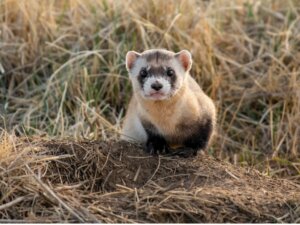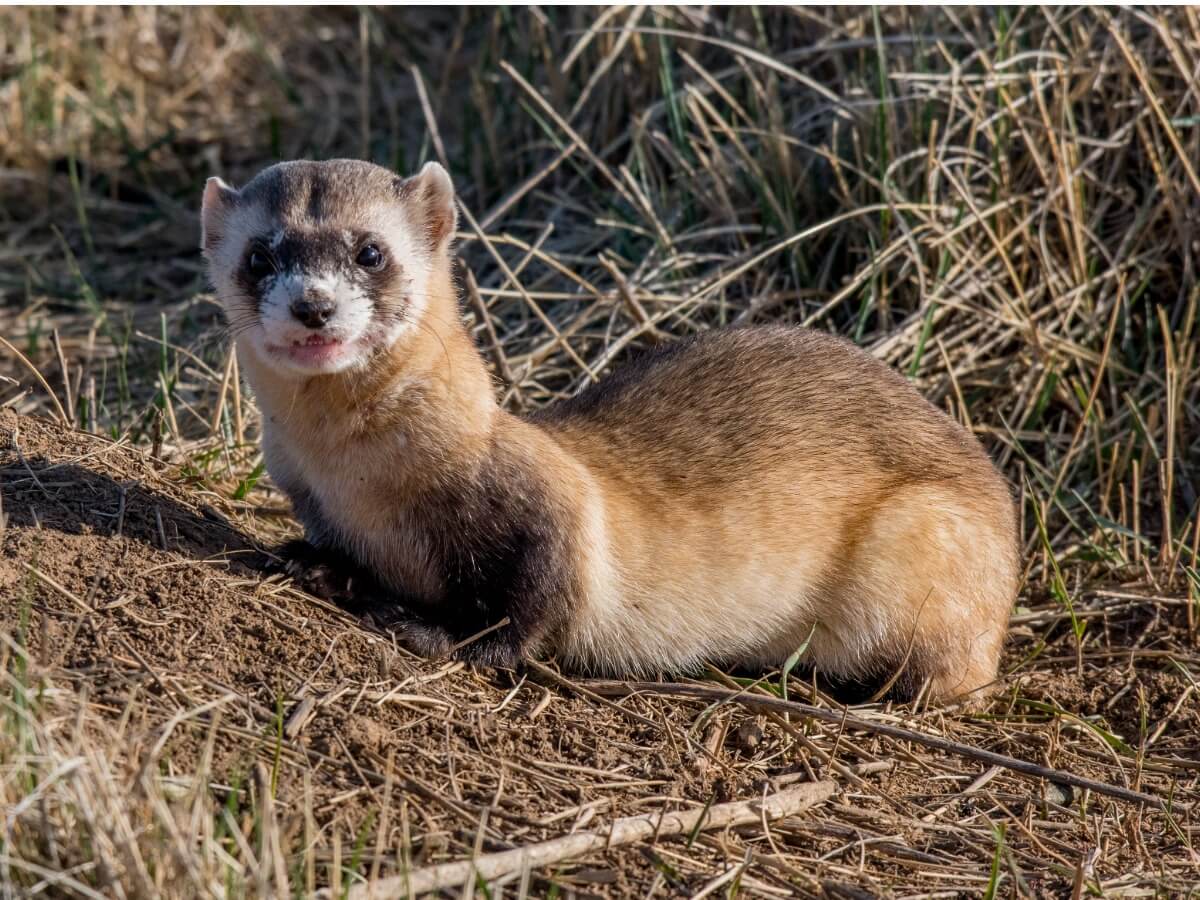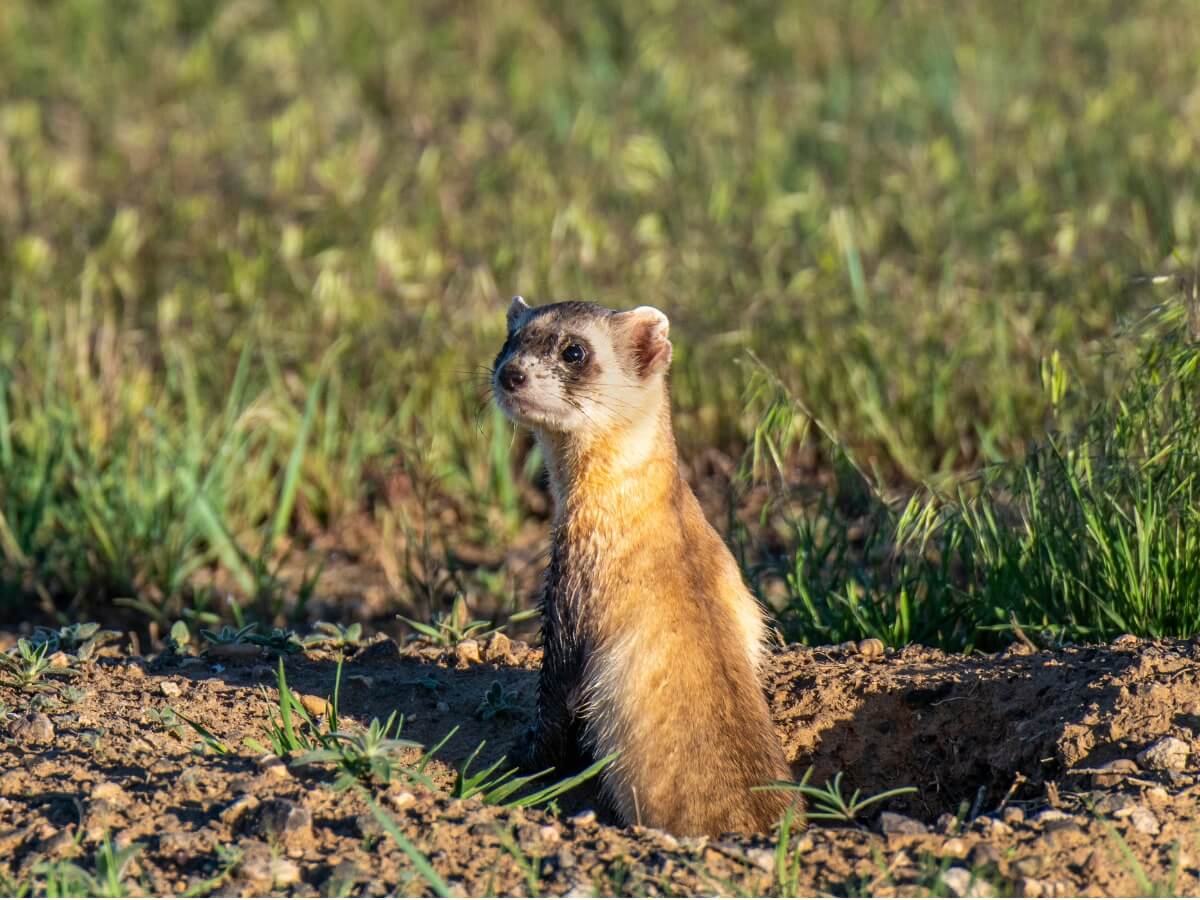Black-Footed Ferret: Habitat and Characteristics

The black-footed ferret (Mustela nigripes) or American polecat is a small mammal that over the decades has had to fight to survive. Despite appearing harmless, this species is characterized by its extensive consumption of other mammals. Thanks to its appearance, the black-footed ferret is often confused with domestic specimens, although there are many differences.
Cloning, protection programs, captive conservation and other strategies have been implemented to guarantee their existence. On the other hand, the domestication of this species has ended its hunting instinct and its solitary habits. Find out more about the black-footed ferret below.
Habitat of the black-footed ferret
The black-footed ferret inhabits open ecosystems, which it usually shares with its main source of food: prairie dogs (Cynomys). In addition, it uses their burrows as a refuge and den, so its habitat depends on the density of the burrow openings of its prey.
In general, it has been observed that the black-footed ferret needs 40 to 60 hectares of foraging potential, and the population density of prairie dogs determines their habitat. Similarly, diseases and the abundance of prairie dog predators has an impact.
Regarding its geographical location, this species currently lives in the United States. It covers approximately 500 km² (310 miles) in an area that includes the states of South Dakota, Wyoming, and Arizona. However, some population traces have also been recorded in Kansas, New Mexico, South Dakota, and Utah, thanks to relocation programs.

Physical characteristics
Physically, the black-footed ferret has a length of 35 to 50 centimeters (13 – 20 inches), in addition to a lined tail 15 centimeters (6 inches) long. As for its weight, it usually ranges between 0.7 and 1.3 kilograms (about 1.5 to 3 inches).
The base of its skin is white, although it darkens at the tips, so it has a yellowish-brown appearance in general. Males are approximately 10% larger than females.
Its distinctive characteristic with respect to other similar species is the black color of its legs. This begins at the hip and ends at the tip of the tail. Similarly, adults of this species have a distinctive head “mask”, which is also black. These colors allow this mammal to blend in with its prairie ecosystem, in which it thrives in a wild way.
The behavior of the black-footed ferret
The black-footed ferret has nocturnal behavioral habits and spends most of its time inside burrows that it steals from prairie dogs. Outside of breeding and rearing times, this species is mostly solitary. For this reason, organizations such as World Wild Life have implemented conservation programs for this species of ferret in prairie dog burrows.
Interestingly, these mammals rely on a series of loud sounds or chatter, with which they warn others. On the other hand, they use a hiss to show their fear and the females call their young with a type of moaning sound. Finally, they rely on a kind of laugh in courtship times, although they also jump and snap as part of their mating ritual.
Feeding and reproduction
Regarding the diet of the black-footed ferret – being a carnivore as mentioned above – its diet is based 90% on prairie dogs. However, when these animals are in hibernation, black-footed ferrets resort to feeding on rats, birds, squirrels, and rabbits.
It’s estimated that an adult black-footed ferret eats approximately 100 prairie dogs in a year. Similarly, it has been observed that without this food source, the species can’t survive in optimal conditions. For prairie dogs, a colony is between 130 and 150 acres. Because of this, there should be at least one colony for each black-footed ferret.
Their reproductive behavior takes place between February and March, and gestation takes between 42 and 45 days. The number of pups usually varies between 1 and 7 individuals, of which only 3 or 4 usually survive. The young are born in the burrows owned by the black-footed ferrets and don’t emerge from them until they’re 6 weeks old.
Black-footed ferrets have a life expectancy of 8 years in captivity and 1 to 4 years in the wild.
The aforementioned young are born practically blind and their fur is white. Vision changes appear after 35 days and dark spots appear on their fur at three weeks of age. Black-legged ferrets reach sexual maturity at one year of age. However, they can only reproduce when they’re 3 or 4 years old. They move to another burrow when they are only a few months old.
State of conservation
Since the black-footed ferret population is dependent on the existence of prairie dog colonies, their population has its ups and downs. Their greatest threat has been pest control measures and the conversion of their natural habitat into farmland. In addition, there’s the problem of farmers who attack and poison prairie dog colonies.
According to the International Union for Conservation of Nature (IUCN), in 2015, there were only 206 wild specimens in their original range. For this reason, the conservation status of the black-footed ferret is currently endangered. Although nowadays this species of ferret isn’t hunted, they’re victims of coyote traps and electric fences.

As you can see, black-footed ferrets are linked to the existence of prairie dogs. At the end of the 20th century, it was possible to take some individuals to breed them in captivity and conserve the species. However, these days the efforts aren’t enough. For this reason, it’s vitally important that non-governmental and state organizations come together to create conservation programs.
The black-footed ferret (Mustela nigripes) or American polecat is a small mammal that over the decades has had to fight to survive. Despite appearing harmless, this species is characterized by its extensive consumption of other mammals. Thanks to its appearance, the black-footed ferret is often confused with domestic specimens, although there are many differences.
Cloning, protection programs, captive conservation and other strategies have been implemented to guarantee their existence. On the other hand, the domestication of this species has ended its hunting instinct and its solitary habits. Find out more about the black-footed ferret below.
Habitat of the black-footed ferret
The black-footed ferret inhabits open ecosystems, which it usually shares with its main source of food: prairie dogs (Cynomys). In addition, it uses their burrows as a refuge and den, so its habitat depends on the density of the burrow openings of its prey.
In general, it has been observed that the black-footed ferret needs 40 to 60 hectares of foraging potential, and the population density of prairie dogs determines their habitat. Similarly, diseases and the abundance of prairie dog predators has an impact.
Regarding its geographical location, this species currently lives in the United States. It covers approximately 500 km² (310 miles) in an area that includes the states of South Dakota, Wyoming, and Arizona. However, some population traces have also been recorded in Kansas, New Mexico, South Dakota, and Utah, thanks to relocation programs.

Physical characteristics
Physically, the black-footed ferret has a length of 35 to 50 centimeters (13 – 20 inches), in addition to a lined tail 15 centimeters (6 inches) long. As for its weight, it usually ranges between 0.7 and 1.3 kilograms (about 1.5 to 3 inches).
The base of its skin is white, although it darkens at the tips, so it has a yellowish-brown appearance in general. Males are approximately 10% larger than females.
Its distinctive characteristic with respect to other similar species is the black color of its legs. This begins at the hip and ends at the tip of the tail. Similarly, adults of this species have a distinctive head “mask”, which is also black. These colors allow this mammal to blend in with its prairie ecosystem, in which it thrives in a wild way.
The behavior of the black-footed ferret
The black-footed ferret has nocturnal behavioral habits and spends most of its time inside burrows that it steals from prairie dogs. Outside of breeding and rearing times, this species is mostly solitary. For this reason, organizations such as World Wild Life have implemented conservation programs for this species of ferret in prairie dog burrows.
Interestingly, these mammals rely on a series of loud sounds or chatter, with which they warn others. On the other hand, they use a hiss to show their fear and the females call their young with a type of moaning sound. Finally, they rely on a kind of laugh in courtship times, although they also jump and snap as part of their mating ritual.
Feeding and reproduction
Regarding the diet of the black-footed ferret – being a carnivore as mentioned above – its diet is based 90% on prairie dogs. However, when these animals are in hibernation, black-footed ferrets resort to feeding on rats, birds, squirrels, and rabbits.
It’s estimated that an adult black-footed ferret eats approximately 100 prairie dogs in a year. Similarly, it has been observed that without this food source, the species can’t survive in optimal conditions. For prairie dogs, a colony is between 130 and 150 acres. Because of this, there should be at least one colony for each black-footed ferret.
Their reproductive behavior takes place between February and March, and gestation takes between 42 and 45 days. The number of pups usually varies between 1 and 7 individuals, of which only 3 or 4 usually survive. The young are born in the burrows owned by the black-footed ferrets and don’t emerge from them until they’re 6 weeks old.
Black-footed ferrets have a life expectancy of 8 years in captivity and 1 to 4 years in the wild.
The aforementioned young are born practically blind and their fur is white. Vision changes appear after 35 days and dark spots appear on their fur at three weeks of age. Black-legged ferrets reach sexual maturity at one year of age. However, they can only reproduce when they’re 3 or 4 years old. They move to another burrow when they are only a few months old.
State of conservation
Since the black-footed ferret population is dependent on the existence of prairie dog colonies, their population has its ups and downs. Their greatest threat has been pest control measures and the conversion of their natural habitat into farmland. In addition, there’s the problem of farmers who attack and poison prairie dog colonies.
According to the International Union for Conservation of Nature (IUCN), in 2015, there were only 206 wild specimens in their original range. For this reason, the conservation status of the black-footed ferret is currently endangered. Although nowadays this species of ferret isn’t hunted, they’re victims of coyote traps and electric fences.

As you can see, black-footed ferrets are linked to the existence of prairie dogs. At the end of the 20th century, it was possible to take some individuals to breed them in captivity and conserve the species. However, these days the efforts aren’t enough. For this reason, it’s vitally important that non-governmental and state organizations come together to create conservation programs.
All cited sources were thoroughly reviewed by our team to ensure their quality, reliability, currency, and validity. The bibliography of this article was considered reliable and of academic or scientific accuracy.
- WWL. Hurón de patas negras. Recogido el 30 de junio de 2021 de: https://www.worldwildlife.org/descubre-wwf/historias/huron-de-patas-negras
- Miller, B., Biggins, D., Hanebury, L., & Vargas, A. (1994). Reintroduction of the black-footed ferret (Mustela nigripes). In Creative conservation (pp. 455-464). Springer, Dordrecht. Recogido el 30 de junio de 2021 de: https://link.springer.com/chapter/10.1007/978-94-011-0721-1_27
- Santymire, R. M., Lavin, S. R., Branvold-Faber, H., Kreeger, J., Che-Castaldo, J., Rafacz, M., & Marinari, P. (2020). Influence of vitamin E and carcass feeding supplementation on fecal glucocorticoid and androgen metabolites in male black-footed ferrets (Mustela nigripes). PloS one, 15(10), e0241085.
- Mackie, P., Chan, B., Franke, M., & Mastromonaco, G. F. (2020). Urethral catheterization as an alternative method for collecting sperm in the black-footed ferret (Mustela nigripes). Conservation Physiology, 8(1), coaa078.
- Pastor, A. R. (2017). Investigating enteric coccidiosis in the black-footed (Mustela nigripes) and domestic ferret (Mustela putorius furo) (Doctoral dissertation).
- Mize, E. L., Grassel, S. M., & Britten, H. B. (2017). Fleas of black-footed ferrets (Mustela Nigripes) and their potential role in the movement of plague. Journal of wildlife diseases, 53(3), 521-531.
This text is provided for informational purposes only and does not replace consultation with a professional. If in doubt, consult your specialist.








